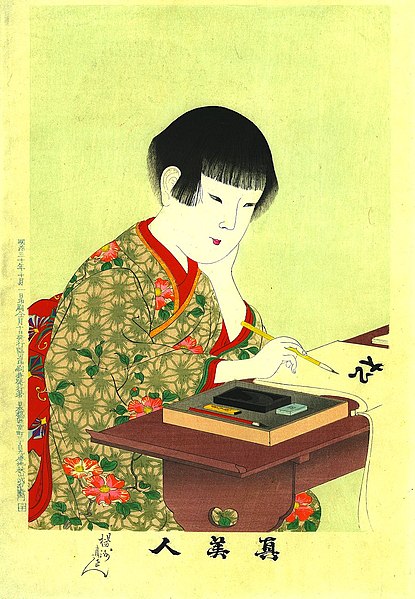The modern Japanese writing system uses a combination of logographic kanji, which are adopted Chinese characters, and syllabic kana. Kana itself consists of a pair of syllabaries: hiragana, used primarily for native or naturalised Japanese words and grammatical elements; and katakana, used primarily for foreign words and names, loanwords, onomatopoeia, scientific names, and sometimes for emphasis. Almost all written Japanese sentences contain a mixture of kanji and kana. Because of this mixture of scripts, in addition to a large inventory of kanji characters, the Japanese writing system is considered to be one of the most complicated currently in use.

Japanese novel using kanji kana majiri bun (text with both kanji and kana), the most general orthography for modern Japanese. Ruby characters (or furigana) are also used for kanji words (in modern publications these would generally be omitted for well-known kanji). The text is in the traditional tategaki ("vertical writing") style; it is read down the columns and from right to left, like traditional Chinese. Published in 1908.
Yokogaki
Kanji are the logographic Chinese characters adapted from the Chinese script used in the writing of Japanese. They were made a major part of the Japanese writing system during the time of Old Japanese and are still used, along with the subsequently-derived syllabic scripts of hiragana and katakana. The characters have Japanese pronunciations; most have two, with one based on the Chinese sound. A few characters were invented in Japan by constructing character components derived from other Chinese characters. After the Meiji Restoration, Japan made its own efforts to simplify the characters, now known as shinjitai, by a process similar to China's simplification efforts, with the intention to increase literacy among the common folk. Since the 1920s, the Japanese government has published character lists periodically to help direct the education of its citizenry through the myriad Chinese characters that exist. There are nearly 3,000 kanji used in Japanese names and in common communication.

Nihon Shoki (720 AD), considered by historians and archaeologists as the most complete extant historical record of ancient Japan, was written entirely in kanji.
A young woman practicing kanji. Ukiyo-e woodblock print by Yōshū Chikanobu, 1897.
A jūbako (重箱), which has a mixed on-kun reading
A yutō (湯桶), which has a mixed kun-on reading






